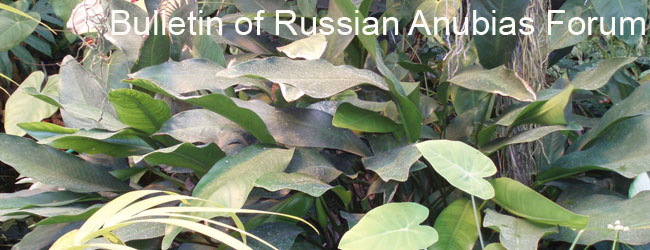Aquarium is quite popular in many countries. Keeping of a small nature corner gives many positive emotions. During last 100 years scientists have succeeded in adapting of many various aquatic animals. Thanks to selection work a great number of new artificial forms were selected. Such forms have a more attractive colouring or appearance as compared with primary kinds. Selection forms of guppy, angelfish and discus fish have already won the hearts of many admirers of this hobby. On the contrary selection work in the sphere of aquatic flora has remained in a nascent state up to date. Interspecific hybrids of Anubias, Aponogeton and Echinodorus do not fully make up scant colouring and forms of natural kinds.
Nano-tanks fashion needs to create tiny forms but it is almost impossible to obtain it by usual crossing. Anubias are large plants and are not to be used in the arrangement of small home aquaria. Anubias barteri var. nana is the smallest natural species, but its lamina length can reach 10-12 cm. This fact explains the use of artificially caused mutations in these plants selection.
In the foreground of this 40 liter tank Anubias barteri var. nana ‘Petite’ and Glossostigma elatinoides complement each other very well.
There are also some mutation processes in nature. Usual mutant forms appear as a result of sexual reproduction as a genome is mostly vulnerable to external factors during fertilization period and seeds formation. However in future all the mutants are doomed to extinction by many reasons. Firstly the majority of received qualities make them noncompetitive with usual (nonmutating) species. Secondly many mutants are sterile and are not capable of further sexual reproduction. Besides in case of insignificant disorders in nature there is a regeneration mechanism of chromosome structure (a system of repairing enzymes). By the first generation it will be impossible to tell mutating individuals from nonmutating ones.
It is necessary to mention that there are 2 mutation types realized in plants selection. Quite weak exposure, for example, of ultraviolet irradiation or of various chemical mutagens causes plastid mutations. They lead to colour change (this will be discussed for the next time). Some serious changes in plants size are possible only if there are genetic disorders inside of a cell nucleus that emerge in case of stronger external exposure – gamma-irradiation. Dwarfish sorts of Anubias, for example, ‘Petite’, ‘Bonsai’, ‘Gabon’ and others were bred by this very method. Each kind is individual as it is obtained in the course of a unique single experiment. Further reproduction is effected in a vegetative way with the use of tissue cultures. That is why all the disputes of aquarians whether ‘Petite’ tells from ‘Bonsai’ or not – are quite absurd. Despite a big similarity of appearance they are likely to be different plants, experimental conditions of their breeding are just similar.
Usually phenotypic changes of dwarfish forms are connected with biosynthesis disorders of phytohormones – gibberellins. These organic compounds belong to the class of terpens and regulate plants growth. It is possible that a cell produces many gibberellins but the signaling mechanism activating the plant growth is broken. In this case the plant growth is slowed down and it does not reach its natural size that is typical of its form.
Despite a great number of raised dwarfish sorts of Anubias, Anubias barteri var. nana is much more popular among aquarians. In aquaria its lamina does not exceed 1 cm and overall bush height – 3 cm that is almost 5-8 times less than the height of its nominative form. This allows to use A. barteri var. nana 'Petite' even in the smallest tanks.
By emersed keeping this plant’s lamina reaches 3 cm. During a 5 - year- cultivation a ‘Petite’ plant has kept its qualities as a sort and in case of vegetative reproduction by rhizome divisions this cultivar does not degenerate into a usual A. barteri var. nana. It remains small and pretty.
Anubias barteri var. nana ‘Petite’ in the Moscow Botanical Garden.
Blooming of dwarfish sorts is a rare occurrence. Under submersed conditions I have never observed buds formation. In a greenhouse ‘Petite’ forms inflorescences proportioned to the laminae. In my case the flower stalk length made up 4 cm and the spadix length – 1.5 cm. The structure of synandria corresponds to the nominative form of Anubias barteri var. nana. Thecae are on a synandrium’s flank. During the whole blooming I did not observe pollen. Although it is typical of such mutants.
The first day of blooming.
The second day of blooming. The structure of male flowers remembers the same structure of Anubias barteri var. nana.
The authors of this note: Dmitry Loginov.
Translated from Russian by Natalia Naboka and Alexander Grigorov.
Photos: Dmitry Loginov and Vladimir Khodakovskiy (http://praeclara.ru).





























